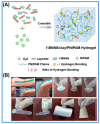Poly(N-isopropylacrylamide)-Based Thermoresponsive Composite Hydrogels for Biomedical Applications
- PMID: 32150904
- PMCID: PMC7182829
- DOI: 10.3390/polym12030580
Poly(N-isopropylacrylamide)-Based Thermoresponsive Composite Hydrogels for Biomedical Applications
Abstract
Poly(N-isopropylacrylamide) (PNIPAM)-based thermosensitive hydrogels demonstrate great potential in biomedical applications. However, they have inherent drawbacks such as low mechanical strength, limited drug loading capacity and low biodegradability. Formulating PNIPAM with other functional components to form composited hydrogels is an effective strategy to make up for these deficiencies, which can greatly benefit their practical applications. This review seeks to provide a comprehensive observation about the PNIPAM-based composite hydrogels for biomedical applications so as to guide related research. It covers the general principles from the materials choice to the hybridization strategies as well as the performance improvement by focusing on several application areas including drug delivery, tissue engineering and wound dressing. The most effective strategies include incorporation of functional inorganic nanoparticles or self-assembled structures to give composite hydrogels and linking PNIPAM with other polymer blocks of unique properties to produce copolymeric hydrogels, which can improve the properties of the hydrogels by enhancing the mechanical strength, giving higher biocompatibility and biodegradability, introducing multi-stimuli responsibility, enabling higher drug loading capacity as well as controlled release. These aspects will be of great help for promoting the development of PNIPAM-based composite materials for biomedical applications.
Keywords: biomedical applications; hydrogels; mechanical strength; poly(N-isopropylacrylamide) (PNIPAM); thermosensitivity.
Conflict of interest statement
The authors declare no conflict of interest.
Figures






Similar articles
-
Refined control of thermoresponsive swelling/deswelling and drug release properties of poly(N-isopropylacrylamide) hydrogels using hydrophilic polymer crosslinkers.J Biomater Sci Polym Ed. 2016 Dec;27(17):1698-1711. doi: 10.1080/09205063.2016.1230933. Epub 2016 Sep 11. J Biomater Sci Polym Ed. 2016. PMID: 27573586
-
Poly(N-isopropylacrylamide)-Based Hydrogels for Biomedical Applications: A Review of the State-of-the-Art.Gels. 2022 Jul 20;8(7):454. doi: 10.3390/gels8070454. Gels. 2022. PMID: 35877539 Free PMC article. Review.
-
Polyethylene glycol (PEG)-Poly(N-isopropylacrylamide) (PNIPAAm) based thermosensitive injectable hydrogels for biomedical applications.Eur J Pharm Biopharm. 2014 Nov;88(3):575-85. doi: 10.1016/j.ejpb.2014.07.005. Epub 2014 Aug 1. Eur J Pharm Biopharm. 2014. PMID: 25092423 Review.
-
Phase transition and potential biomedical applications of thermoresponsive compositions based on polysaccharides, proteins and DNA: A review.Int J Biol Macromol. 2023 Sep 30;249:126054. doi: 10.1016/j.ijbiomac.2023.126054. Epub 2023 Jul 31. Int J Biol Macromol. 2023. PMID: 37532189 Review.
-
Smart Poly(N-isopropylacrylamide)-Based Hydrogels: A Tour D'horizon of Biomedical Applications.Gels. 2025 Mar 15;11(3):207. doi: 10.3390/gels11030207. Gels. 2025. PMID: 40136912 Free PMC article. Review.
Cited by
-
Design of Bio-Conjugated Hydrogels for Regenerative Medicine Applications: From Polymer Scaffold to Biomolecule Choice.Molecules. 2020 Sep 7;25(18):4090. doi: 10.3390/molecules25184090. Molecules. 2020. PMID: 32906772 Free PMC article. Review.
-
A scalable and tunable thermoreversible polymer for 3D human pluripotent stem cell biomanufacturing.iScience. 2022 Aug 25;25(10):104971. doi: 10.1016/j.isci.2022.104971. eCollection 2022 Oct 21. iScience. 2022. PMID: 36147944 Free PMC article.
-
Advantages and Prospective Implications of Smart Materials in Tissue Engineering: Piezoelectric, Shape Memory, and Hydrogels.Pharmaceutics. 2023 Sep 20;15(9):2356. doi: 10.3390/pharmaceutics15092356. Pharmaceutics. 2023. PMID: 37765324 Free PMC article. Review.
-
3D-Printed Microcubes for Catalase Drug Delivery.ACS Omega. 2023 Jul 20;8(30):26775-26781. doi: 10.1021/acsomega.3c00789. eCollection 2023 Aug 1. ACS Omega. 2023. PMID: 37546651 Free PMC article.
-
Hydrogel-Based Innovations in Carpal Tunnel Syndrome: Bridging Pathophysiological Complexities and Translational Therapeutic Gaps.Gels. 2025 Jan 9;11(1):52. doi: 10.3390/gels11010052. Gels. 2025. PMID: 39852023 Free PMC article. Review.
References
-
- Jonker A.M., Löwik D.W.P.M., van Hest J.C.M. Peptide- and Protein-based hydrogels. Chem. Mater. 2012;24:759–773. doi: 10.1021/cm202640w. - DOI
-
- Di X., Kang Y., Li F., Yao R., Chen Q., Hang C., Xu Y., Wang Y., Sun P., Wu G. Poly(N-isopropylacrylamide)/polydopamine/clay nanocomposite hydrogels with stretchability, conductivity, and dual light- and thermo- responsive bending and adhesive properties. Colloids Surf. B Biointerfaces. 2019;177:149–159. doi: 10.1016/j.colsurfb.2019.01.058. - DOI - PubMed
Publication types
Grants and funding
LinkOut - more resources
Full Text Sources
Other Literature Sources

